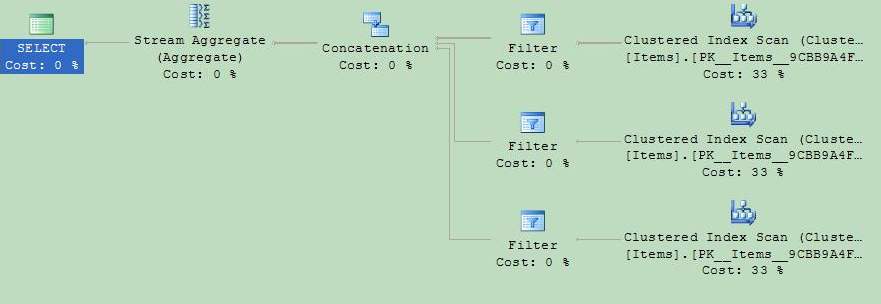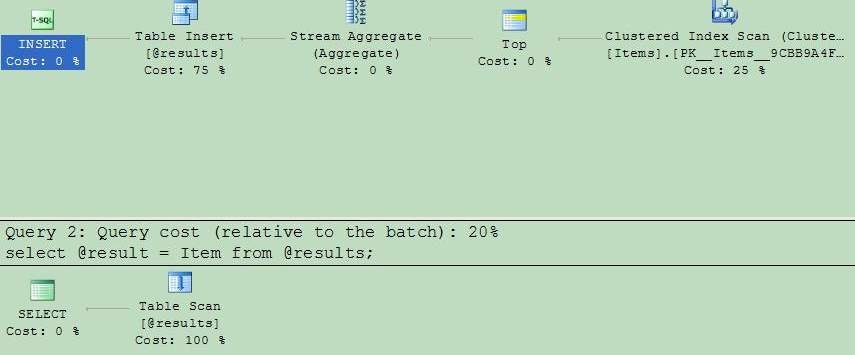Yesterday, by accident, we've seen an article about some design principles
of V8 JavaScript Engine.
It made clearer what techniques are used in today's script implementations.
In particular V8 engine optimizes property access using "dynamically
created
hidden classes". These are structures to store object's layout, they
are derived when ש new property is created (deleted) on the object. When code
accesses a property, and if a cached object's dynamic hidden class is available
at the code point then access time is comparable to one of native fields.
In our opinion this tactics might lead to a proliferation of such dynamic hidden
classes, which requires a considerable housekeeping, which also slows property
write access, especially when it's written for the first time.
We would like to suggest a slightly different strategy, which exploits the
cache matches, and does not require a dynamic hidden classes.
Consider an implementation data type with following characteristics:
- object is implemented as a hash map of property id to property value: Map<ID, Value>;
- it stores data as an array of pairs and can be accessed directly: Pair<ID,
Value> values[];
- property index can be acquired with a method: int index(ID);
A pseudo code for the property access looks like this:
pair = object.values[cachedIndex];
if (pair.ID == propertyID)
{
value = pair.Value;
}
else
{
// Cache miss.
cachedIndex = object.index(propertyID);
value = objec.values[cachedIndex].Value;
}
This approach brings us back to dictionary like implementation but with
important optimization of array speed access when property index is cached, and
with no dynamic hidden classes.
@michaelhkay Saxon 9.4 is out.
But why author does not state that HE version is still xslt/xpath 2.0, as neither xslt maps, nor function items are supported.
Recently, we have found and reported the bug in the SQL Server 2008 (see SQL Server 2008 with(recompile), and also Microsoft Connect).
Persons, who's responsible for the bug evaluation has closed it, as if "By Design". This strange resolution, in our opinion, says about those persons only.
Well, we shall try once more (see Microsoft Connect). We have posted another trivial demonstartion of the bug, where we show that option(recompile) is not used, which leads to table scan (nothing worse can happen for a huge table).
Recently we have introduced some stored procedure in the production and have
found that it performs incredibly slow.
Our reasoning and tests in the development environment did not manifest any
problem at all.
In essence that procedure executes some SELECT and returns a status as a signle
output variable. Procedure recieves several input parameters, and the SELECT
statement uses
with(recompile) execution hint to optimize the performance for a specific
parameters.
We have analyzed the execution plan of that procedure and have found that it
works as if with(recompile) hint was not specified. Without that hint SELECT
failed to use index seek but rather used index scan.
What we have lately found is that the same SELECT that produces result set
instead of reading result into a variable performs very well.
We think that this is a bug in SQL Server 2008 R2 (and in SQL Server 2008).
To demonstrate the problem you can run this test:
-- Setup
create table dbo.Items
(
Item int not null primary key
);
go
insert into dbo.Items
select 1
union all
select 2
union all
select 3
union all
select 4
union all
select 5
go
create procedure dbo.GetMaxItem
(
@odd bit = null,
@result int output
)
as
begin
set nocount on;
with Items as
(
select * from dbo.Items where @odd is null
union all
select * from dbo.Items where (@odd = 1) and ((Item & 1) = 1)
union all
select * from dbo.Items where (@odd = 0) and ((Item & 1) = 0)
)
select @result = max(Item) from Items
option(recompile);
end;
go
create procedure dbo.GetMaxItem2
(
@odd bit = null,
@result int output
)
as
begin
set nocount on;
declare @results table
(
Item int
);
with Items as
(
select * from dbo.Items where @odd is null
union all
select * from dbo.Items where (@odd = 1) and ((Item & 1) = 1)
union all
select * from dbo.Items where (@odd = 0) and ((Item & 1) = 0)
)
insert into @results
select max(Item) from Items
option(recompile);
select @result = Item from @results;
end;
go
Test with output into a variable:
declare @result1 int;
execute dbo.GetMaxItem @odd = null, @result = @result1 output

Test without output directly into a variable:
declare @result2 int;
execute dbo.GetMaxItem2 @odd = null, @result = @result2 output

Now, you can see the difference: the first execution plan uses startup expressions, while the second optimizes execution branches, which are not really used.
In our case it was crucial, as the execition time difference was minutes (and
more in future) vs a split of second.
See also
Microsoft Connect Entry.
A bit history: the first release of this solution was about 9.5 years ago...
Today we've run into a strange situation. One of our clients ask us about automatic conversion of data from mainframe (that were defined as COBOL copybooks) into XML or Java/.NET objects. On our suggestion to use eXperanto, which is well known to him, he stated that he wouldn't like to use a tool of a company that is no more exists...
The situation, in our opinion, become more strange when you consider the following:
- eXperanto (the design-time tool and run-time libraries for Java and .NET) were developed, well tested, and delivered by us to production already several years ago.
- the client bought this set (the tool and libraries).
- the set is in production yet already in another big company, and is used time to time by our company in different migration projects.
- the client talks with developers of this tool and run-time libraries, and he knows about this fact.
- the client uses widely open source solutions even without dedicated vendors or support warranties.
It has happened so, that we have never worked with jQuery, however were aware of
it.
In early 2000 we have developed a web application that contained rich javascript
APIs, including UI components. Later, we were actively practicing in ASP.NET, and
later in JSF.
At present, looking at jQuery more closely we regret that we have failed to
start using it earlier.
Separation of business logic and presentation is remarkable when one uses JSON
web services. In fact server part can be seen as a set of web services
representing a business logic and a set of resources: html, styles, scripts,
others. Nor ASP.NET or JSF approach such a consistent separation.
The only trouble, in our opinion, is that jQuery has no standard data binding: a way to bind JSON data
to (and from) html controls. The technique that will probably be standardized is called jQuery Templates or JsViews
.
Unfortunatelly after reading about this
binding API, and
being in love with Xslt and XQuery we just want to cry. We don't know what would
be the best solution for the task, but what we see looks uncomfortable to us.
Incidentally, we have found one new implementation of yield return in java that is
in the development stage. Sources can be found at
https://github.com/peichhorn/lombok-pg/zipball/master. Just to be sure we
have copied those sources at other place
peichhorn-lombok-pg-0.10.0-39-g384fb7b.zip (you may search "yield"
in the archive).
It's broken according to source tracker, but the funny thing is that sources,
however different, still resemble our yield return implementation (Yield.jar,
Yield.3.7.jar
- Indigo, Yield.zip
- sources) very much: variable names, error messages, algorithmic structure.
Those programmers probably have forgotten good manners: to reference a base work,
at least.
Well, we generously forgive them this blunder.
P.S. our implementation, in contrast, works without bugs.
P.P.S. misunderstanding is resolved. See comments.
A couple of weeks ago, we have suggested to introduce a enumerator function into
the XPath (see
[F+O30] A enumerator function):
I would like the WG to consider an addition of a function that turns a sequence
into a enumeration of values.
Consider a function like this:
fn:enumerator($items as item()*) as function() as item()?;
alternatively, signature could be:
fn:enumerator($items as function() as item()*) as function() as item()?;
This function receives a sequence, and returns a function item, which upon N's
call shall return N's element of the original sequence. This way, a sequence of
items is turned into a function providing a enumeration of items of the
sequence.
As an example consider two functions:
a) t:rand($seed as xs:double) as xs:double* - a function producing a random
number sequence;
b) t:work($input as element()) as element() - a function that generates output
from it's input, and that needs random numbers in the course of the execution.
t:work() may contain a code like this:
let $rand := fn:enumerator(t:rand($seed)),
and later it can call $rand() to get a random numbers.
Enumerators will help to compose algorithms where one algorithm communicate
with other independant algorithms, thus making code simpler. The most obvious
class of enumerators are generators: ordered numbers, unique identifiers,
random numbers.
Technically, function returned from fn:enumerator() is nondetermenistic, but its "side effect" is
similar to a "side effect" of a function generate-id() from a newly created
node (see bug #13747, and bug #13494).
The idea is inspired by a generator function, which returns a new value upon each
call.
Such function can be seen as a stateful object. But our goal is to look at
it in a more functional way. So, we look at the algorithm as a function that
produces a sequence of output, which is pure functional; and an enumerator that
allows to iterate over algorithm's output.
This way, we see the function that implements an algorithm and the function that
uses it can be seen as two thread of functional programs that use messaging to
communicate to each other.
Honestly, we doubt that WG will accept it, but it's interesting to watch the
discussion.
More than month has passed since we have reported a problem to the saxon forum (see
Saxon optimizer bug and
Saxon 9.2 generate-id() bug).
The essence of the problem is that we have constructed argumentless function to
return a unique identifiers each time function is called. To achieve the effect
we have created a temporary node and returned its generate-id() value.
Such a function is nondetermenistic, as we cannot state that its result depends
on arguments only. This means that engine's optimizer is not free to reorder
calls to such a function. That's what happens in Saxon 9.2, and Saxon 9.3 where
engine elevates function call out of cycle thus producing invalid results.
Michael Kay, the author of the Saxon engine, argued that this is "a gray area of
the xslt spec":
If the spec were stricter about defining exactly when you can rely on identity-dependent
operations then I would be obliged to follow it, but I think it's probably deliberate
that it currently allows implementations some latitude, effectively signalling to
users that they should avoid depending on this aspect of the behaviour.
He adviced to raise a bug in the w3c bugzilla to resolve the issue. In the end
two related bugs have been raised:
- Bug 13494
- Node
uniqueness returned from XSLT function;
- Bug 13747
- [XPath 3.0] Determinism of expressions returning constructed nodes.
Yesterday, the WG has resolved the issue:
The Working Group agreed that default behavior should continue to require these
nodes to be constructed with unique IDs.
We believe that this is the kind of thing implementations can do with
annotations or declaration options, and it would be best to get implementation
experience with this before standardizing.
This means that the technique we used to generate unique identifiers is correct
and the behaviour is well defined.
The only problem is to wait when Saxon will fix its behaviour accordingly.
We're not big fans of
Entity Framework, as we don't directly expose the database structure to
the client program but rather through stored procedures and functions. So, EF for
us is a tool to expose those stored procedures as .NET wrappers. This limited use
of EF still greatly automates the data access code.
But what we have lately found is that the EF has a problem with char parameters. Namely,
if you import a procedure say MyProc that accepts char(1),
and then will call it through the generated wrapper, the you will see in sql profiler
that char(1) parameter is passed with many trailing spaces as if it
were char(8000). There isn't necessity to prove that this is highly
ineffective.
We can see that the problem happens in VS 2010 designer rather than in the EF runtime,
as SP's parameters are not attributed with length, see model xml (*.edmx):
<Function Name="MyProc" Schema="Data">
...
<Parameter Name="recipientType" Type="char" Mode="In"
/>
...
</Function>
while if we set:
<Parameter Name="recipientType" Type="char" MaxLength="1"
Mode="In" />
the runtime starts working as expected. So the workaround is to fix model file manually.
See also:
Stored Proc and Char parm
Please welcome a new human being Masha Vladimirovna Nesterovsky!

AjaxControlToolkit has methods to access ViewState:
protected V GetPropertyValue<V>(string propertyName, V nullValue)
{
if (this.ViewState[propertyName] == null)
{
return nullValue;
}
return (V) this.ViewState[propertyName];
}
protected void SetPropertyValue<V>(string propertyName, V value)
{
this.ViewState[propertyName] = value;
}
...
public bool EnabledOnClient
{
get { return base.GetPropertyValue("EnabledOnClient", true); }
set { base.SetPropertyValue("EnabledOnClient", value); }
}
We find that code unnecessary complex and nonoptimal. Our code to access
ViewState looks like this:
public bool EnabledOnClient
{
get { return ViewState["EnabledOnClient"] as bool? ?? true); }
set { ViewState["EnabledOnClient"] = value; }
}
1. query.dll vs tquery.dll
We have installed
Windows Search 4 on a Windows 2003 server. The goal was to index huge compressed
xml files (see
Windows Search Notifications). But for some reason it did not want to index
content.
No "select System.ItemUrl from SystemIndex where contains('...')"
has ever returned a row.
We thought that the problem was in our protocol handler, and tried to localize it,
but finally have discovered that Windows Search is not able to find anything within
text files.
Registry comparision has shown that *.txt extension was indexed by the IFilter defined
in the query.dll, while on the other computers, where everything worked, the implementation
was in the tquery.dll.
Both libraries were present on the Windows 2003 server, so we have corrected the
registry and everything has started to work.
As far as we understand query.dll is part of legacy
Indexing Service, and tquery.dll is up to date implementation.
2. Search index size
We have to index a considerable amout of data. But before we can do it we have to
estimate the size of index.
In the past it seems we saw somewhere a statement that search index needs a storage
that's about 10% of original data for its purposes. Unfortunatelly we cannot
find this estimation at present, neither we cannot find any other estimation. This
complicates our planning.
To get empirical estimate we've indexed several thousands *.xml-gz files, which
are gz'ed big xmls. The total size of this files is about 4.5GB. Total uncompressed
size of xmls ~50GB. Xml contained about 10 millions pages of data.
According to 10% criteria we had to arrive to ~5GB search index.
But what we have discovered is that the index has grown to more than 50GB. That's
very disappointing. We cannot afford such expense, as we've commited test on
a tiny part of data, which increases over time.
So, the solution is to find out what's wrong, and how can it be cured, or to
fulltext index only most recent subset of data.
P.S. We have tried to mark folder with search index as compressed, but it did not
work.
P.P.S. We have found the reference to Windows Search 4 index size estimation. It is in
Windows Search Frequently Asked Questions, see answer on "What is average size of a user's index?" question.
Yesterday (2011-07-31) we have finished the project (development and support) of
the modernization of Cool:GEN code base to java for the
Chicago Mercantile Exchange.
It wasn't the first such project but definitely most interesting. We have migrated
and tested about 300 MB of source code. In the process of translation we have
identified many bugs that were present in the original code. Thanks to
languages-xom that task turned to be pure xslt.
We hope that CME's developers are pleased with results.
If you by chance is looking for Cool:GEN conversion to java, C#, or even COBOL
(don't understand why people still asking for COBOL) then you can start at
bphx site.
|